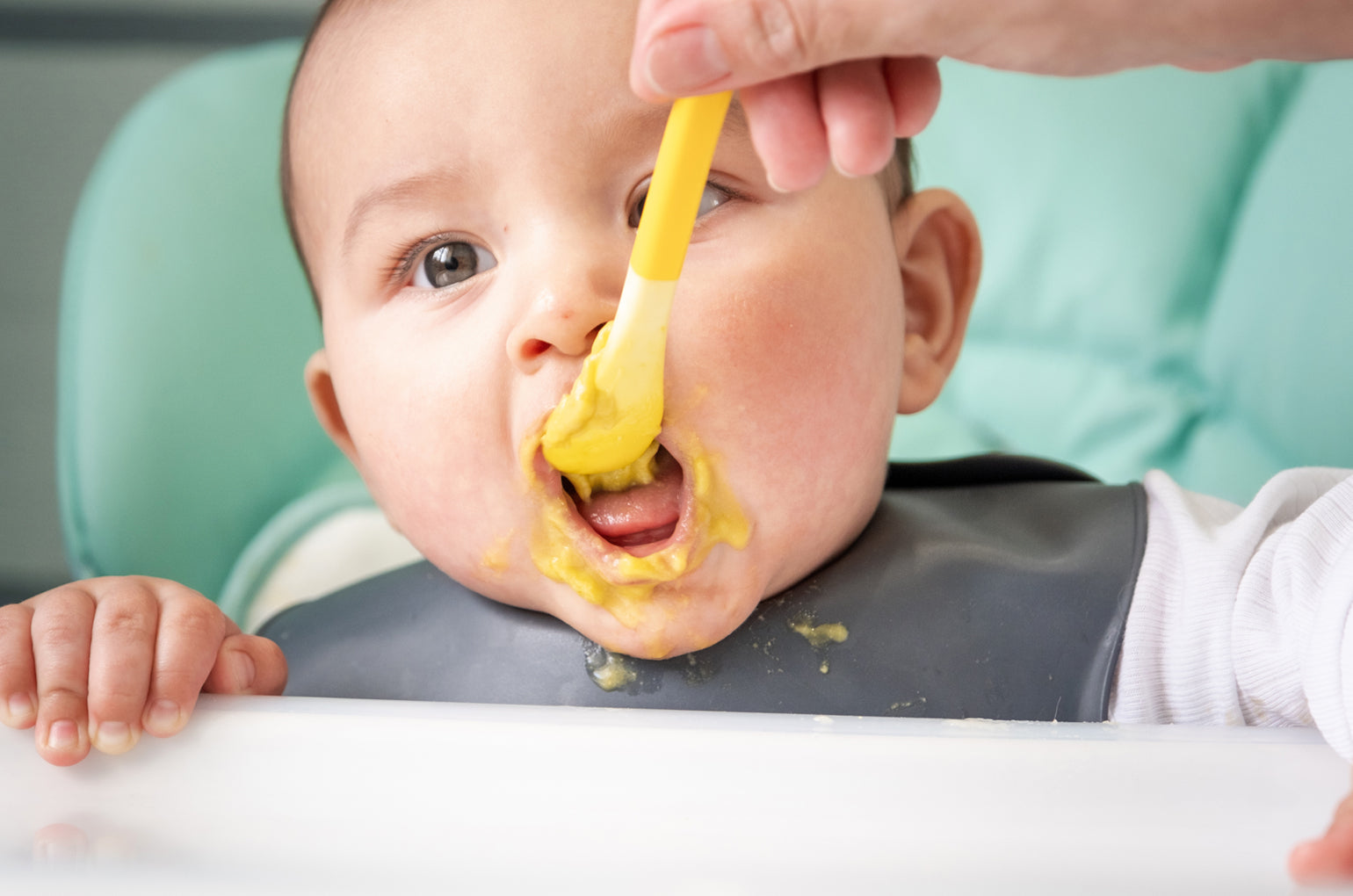
The Baby-Led Weaning (BLW): Approach and Best Practices
Baby-Led Weaning (BLW) has emerged as a contemporary approach to introducing solid foods to infants. In stark contrast to the conventional method of spoon-feeding purees, BLW hands the reins of exploration over to the baby, encouraging them to take charge of their feeding journey. In this introduction, we'll delve into the fundamental principles of BLW and explore why it has gained widespread popularity among parents seeking to foster independence and healthy eating habits in their little ones.
At its essence, BLW is about recognizing and respecting a baby's natural curiosity and developmental readiness for solid foods. Typically initiated around six months of age, when most infants display the physical and developmental markers necessary for safe self-feeding, BLW involves offering them appropriately sized and textured pieces of food. The baby, in turn, explores these offerings, grasping, tasting, and consuming them independently. BLW encourages autonomy and allows the baby to set the pace, creating an enriching experience that goes beyond nourishment.
Benefits of Baby-Led Feeding (BLW)
Baby-Led Weaning (BLW) offers a multitude of advantages for both babies and their parents, making it a compelling choice for those seeking a holistic approach to introducing solid foods.
Encouraging Self-Feeding and Independence
- BLW empowers infants to take control of their eating experiences. Instead of being spoon-fed by caregivers, babies are encouraged to pick up, examine, and eat foods independently.
- This early introduction to self-feeding allows babies to make choices about what they eat and how much they consume, fostering a sense of autonomy from an early age.
- Autonomy in eating can lead to a healthier relationship with food as children grow, promoting a sense of responsibility and self-awareness regarding their dietary choices.
Development of Fine Motor Skills
- BLW provides a unique opportunity for babies to refine their fine motor skills and hand-eye coordination.
- As infants handle a variety of foods with different textures and shapes, they learn to grip, pinch, and manipulate objects effectively.
- These early motor skill developments are not only crucial for self-feeding but also serve as a foundation for later milestones such as using utensils and engaging in activities that require dexterity.
Enhanced Food Acceptance and Diverse Palate
- BLW exposes babies to a wide array of flavors, textures, and foods right from the start of their solid food journey.
- Research indicates that early exposure to diverse foods can lead to increased food acceptance and a more adventurous palate.
- Babies who practice BLW are often more willing to try a variety of foods, reducing the likelihood of developing picky eating habits in the future.
- This exposure can be especially beneficial for introducing healthy foods and incorporating a wide range of nutrients into a baby's diet.
Parent-Child Bonding Through Shared Meals
- BLW encourages shared mealtimes where parents and babies sit together, exploring and enjoying food as a family.
- This shared experience fosters a positive association with mealtime, making it an enjoyable and interactive part of daily life.
- The act of eating together strengthens the bond between parents and their infants, providing opportunities for early socialization and learning.
- Shared meals during BLW create lasting memories and establish a foundation for a positive attitude toward food, setting the stage for a lifetime of enjoyable and health-conscious eating habits.
Preparing for Baby-Led Weaning
When you are thinking about initiating the Baby-Led Weaning (BLW) process, thorough preparation is essential to ensure a safe and successful experience for both parents and their little ones. Here's a breakdown of several important aspects to consider:
When to Start BLW (Around 6 Months)
- Starting BLW at around six months aligns with the recommended age for introducing solids by leading health organizations, including the World Health Organization (WHO) and the American Academy of Pediatrics (AAP).
- At this age, most babies have developed the necessary physical and developmental skills to begin self-feeding. They can typically sit up with support and exhibit the curiosity and coordination required to explore solid foods.
- Introducing solids around six months also coincides with a natural decline in the protective reflex that pushes food out of a baby's mouth, reducing the likelihood of choking.
- Delaying the introduction of solids beyond six months can risk nutritional deficiencies and may miss the optimal window for developing acceptance of a wide range of foods.
Safety Precautions and Choking Hazards
- Safety is paramount during BLW, and parents should be vigilant to minimize choking hazards.
- Foods should be prepared to minimize risks. This includes cutting or breaking food into pieces that are easy for a baby to grasp but not small enough to pose a choking risk.
- Parents should take CPR and first-aid courses to be prepared for any emergency situations and should always have access to emergency contact numbers.
Essential Baby-Led Weaning Tools and Equipment
Certain tools and equipment can enhance the BLW experience, making it safer and more enjoyable for both parents and babies.
- Highchair: A sturdy, well-designed highchair provides a safe and supportive space for your baby during mealtimes. It allows them to sit comfortably and maintain an upright posture, reducing the risk of choking.
- Baby-friendly utensils: Soft-tipped or silicone-tipped spoons and forks are designed with the comfort and safety of little mouths in mind. They facilitate the transition to self-feeding and help babies explore textures.
- Sippy cups or open cups: Introducing a cup alongside BLW encourages the development of early drinking skills, transitioning babies from breast or bottle feeding to drinking from a cup.
- Bibs and easy-to-clean placemats: Babies exploring solid foods can be messy eaters. Waterproof bibs and placemats designed for easy cleaning help contain messes and simplify cleanup.
By paying careful attention to these aspects, parents can create a safe, nurturing, and interactive environment for their baby's BLW journey, ensuring that the introduction to solids is a positive and developmentally appropriate experience.
Choosing the Right Foods
Starting BLW with appropriate first foods is essential for a smooth transition to solids. Initially, opt for foods that are easy to grasp and manipulate, as well as gentle on your baby's developing digestive system. Soft fruits like ripe banana or mashed avocado, well-cooked vegetables such as sweet potato or steamed broccoli, and finely shredded or flaked proteins like tofu or legumes are excellent choices. Introduce these foods one at a time, allowing your baby to explore their textures and flavors gradually.
Babies have unique nutritional needs, especially during their early stages of development. For vegan or vegetarian families, it's essential to ensure that your baby's BLW diet provides all the necessary nutrients. While breast milk or formula should remain the primary source of nutrition, as your baby's self-feeding skills improve, you can begin to incorporate complementary solid foods.
To meet essential nutrient requirements:
- Focus on iron-rich plant-based foods such as fortified cereals, tofu, lentils, and dark leafy greens like spinach.
- Pay attention to sources of healthy fats, such as avocados, nuts, and seeds - in an age appropriate texture.
- Vitamin B12 is a critical nutrient that can be challenging to obtain from a vegan diet, so consider fortified foods or supplements and advise with your health care provider regarding B12 supplementation.
- Exposure to sunlight and fortified foods may help meet vitamin D needs.
- Incorporate omega-3 fatty acids through sources like ground flaxseeds, chia seeds, and walnuts.
Guidelines for Introducing Allergenic Foods
When introducing allergenic foods, follow recommended guidelines, such as introducing one new allergenic food at a time, regardless of dietary preferences. Pay close attention to your baby for potential allergic reactions, such as hives, swelling, or digestive discomfort. By focusing on a variety of suitable first foods, nutritional considerations, and allergenic food introductions, you can ensure that your baby's BLW experience is both nutritious and enjoyable.
Conclusion
Baby-Led Weaning (BLW) represents a transformative approach to introducing solids to infants, emphasizing independence, exploration, and healthy eating habits from the very beginning. By embracing BLW, parents empower their babies to take the lead in their feeding journey, promoting self-feeding, fine motor skill development, diverse palates, and strengthened parent-child bonds. Adequate preparation, from understanding the right time to start BLW to ensuring a safe mealtime environment, is essential.
Choosing suitable first foods, addressing nutritional considerations, and introducing allergenic foods cautiously are pivotal steps in providing a balanced BLW experience. Whether following a traditional or specific dietary path, practical tips such as creating a conducive mealtime environment, letting the baby take the lead, managing mess with patience, and balancing milk feeds with solids ensure a successful and rewarding BLW journey. Ultimately, BLW sets the stage for a lifetime of healthy eating habits and independence, fostering a positive relationship between babies and food that can last a lifetime.

